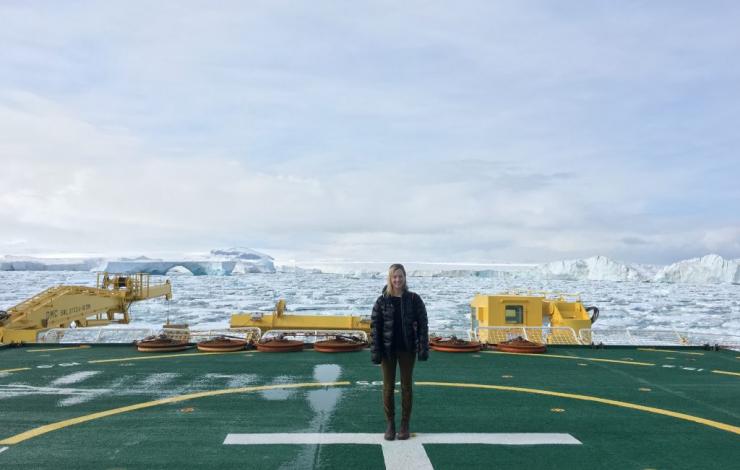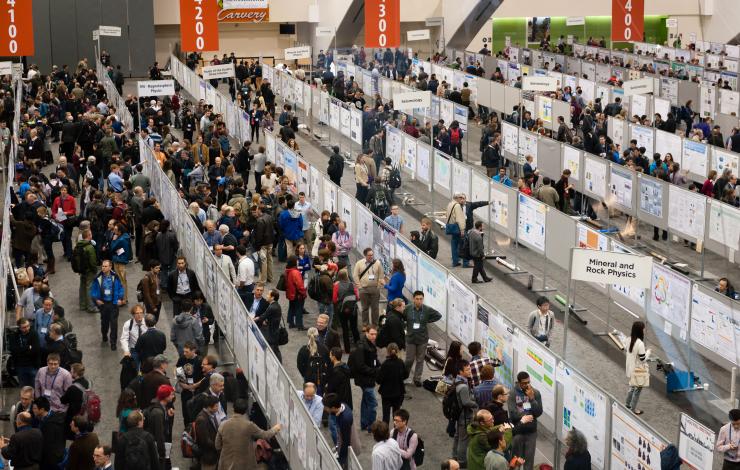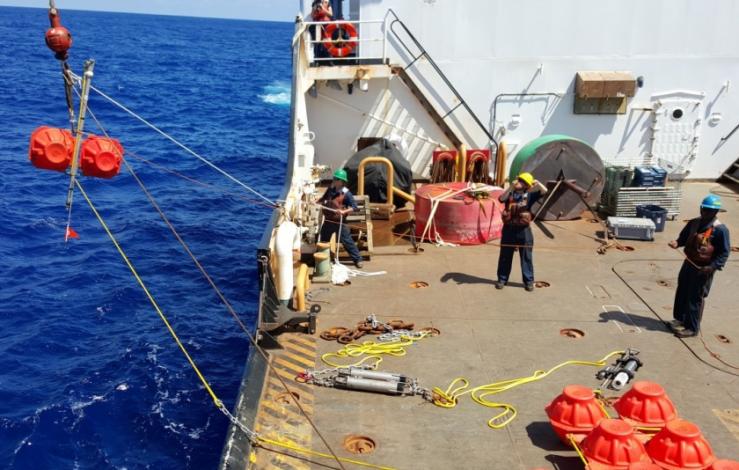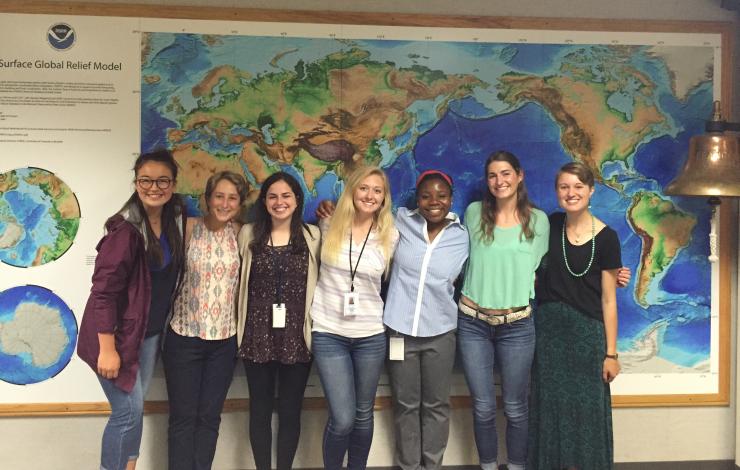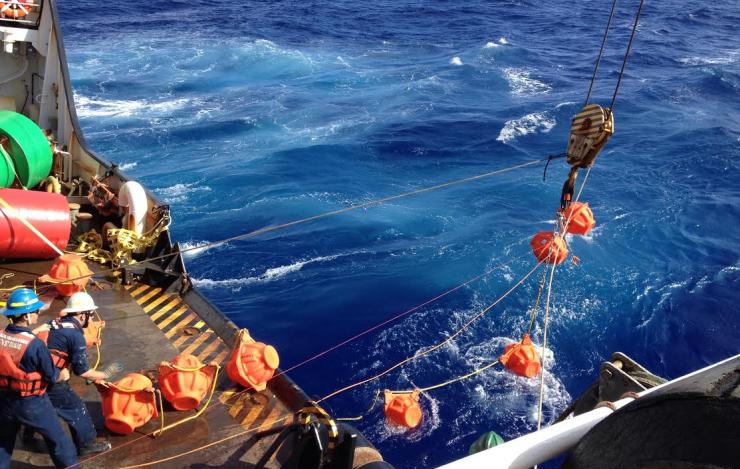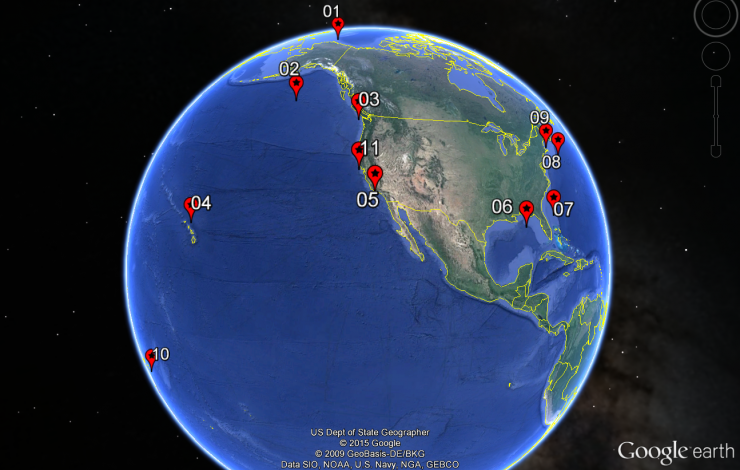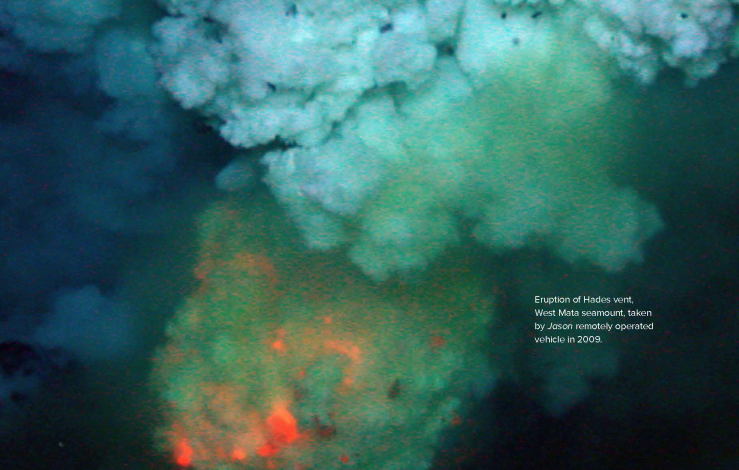What's New Archive
From January 21 - March 2, Lauren Roche from the PMEL Acoustics Program will be aboard the R/V Araon deploying six hydrophones (shown in the image below in the Ross Sea, Antarctica. The objective of this research cruise is to use various land- and ship-based research methods to gain a thorough understanding of the Terra Nova Bay region. The PMEL Acoustics Program has been collaborating with the Korea Polar Research Institute (KOPRI) for several years on multiple projects in Antarctica. On this research cruise, Lauren will be replacing a hydrophone triad near the Drygalski Ice Tongue that was deployed last year as well as deploying a second triad in a new location further north. The data collected from these deployments will allow the Acoustics program to characterize the soundscape of the Terra Nova Bay polynya.
On February 8, Lauren successfully recovered hydrophones that likely recorded the Nansen glacier calving event. Read more about the event and the Nansen ice shelf here: http://www.esa.int/Our_Activities/Observing_the_Earth/Copernicus/Sentinel-1/Nansen_gives_birth_to_two_icebergs
Lauren Roche is a new mooring technician with PMEL Acoustics Program through Oregon State University’s Cooperative Institute for Marine Resources Studies (CIMRS). Her background is in bioacoustics and fisheries and will be deploying, recovering, and building the hydrophones for the group. Learn more about the acoustics program here.
PMEL scientists, including scientists from the University of Washington's Joint Institute for the Study of the Ocean and Atmosphere (JISAO) and Oregon State University's Cooperative Institute for Marine Resources Studies (CIMRS) are attending the American Geophysical Union (AGU)’s Annual Meeting in San Francisco this week, December 12-16. AGU's Falling Meeting is the largest Earth and space science meeting in the world bringing together the Earth and space science community for discussions of emerging trends and the latest research. Poster and talk topics include data integration, El Nino Southern Oscillation (ENSO), Indian Ocean temperature trends, hydrothermal plumes and vents, carbon dioxide in the tropics and Gulf of Alaska, aerosol research, and heat impacts on marine ecosystems and fisheries, tsunamis, and acoustic research.
The 2016 Arctic Report Card will be released Tuesday morning in conjunction with a press conference led by NOAA’s Jeremy Mathis. The 2016 Arctic Report Card brings together the work of 61 scientists from 11 nations to provide the latest information on multiple measures of Arctic environmental change, including air and sea surface temperature, sea ice, snow cover, vegetation, wildlife, and plankton abundance. Read the full report and highlights here as well as the press release. Watch the recorded press conference here.
Researchers will also present during a press conference Thursday morning some of the first scientific results from the 2015 Axial Seamount eruption including discoveries of previously unknown structures and new glimpses into the volcano’s internal plumbing. These new insights into the world’s most active and well-studied underwater volcano may help scientists better understand all volcanoes and the hazards they pose. Read the press release here. Watched the recorded press conference here.
Dr. Bob Embley from the Earth-Ocean Interactions group will be honored during the Awards Ceremony as part of the 2016 class of Fellows for his pioneering contributions to the understanding of deep-sea volcanism by fostering interdisciplinary investigations with advanced technologies.
PMEL’s Acoustics Program is the focus of the first of three videos that will appear in Ocean Today Kiosks. Listen to Bob Dziak, Haru Matsumoto and Joe Haxel talk about their work at Challenger Deep. In the summer of 2015, PMEL and CIMRS scientists set out to Challenger Deep to record ambient noise at the deepest known location in Earth’s oceans. What they heard, surprised them all. Watch the video on YouTube. This video was produced by 77th Parallel Productions and Jesse Crowell.
Read more about their findings here and learn more about the Acoustic Program.
This summer, NOAA’s Pacific Marine Environmental Lab is mentoring six undergraduate Hollings scholars and one NSF research experience for undergraduates (REU) student. These students come from all over the United States and all have a passion for the marine environment. The summer internships provide each student with hands-on research experience as they work closely with a mentor. This year, the undergraduates are placed in the Acoustics, Arctic, Carbon, Ocean Climate Stations, Atmospheric Chemistry and Large Scale Ocean Physics groups and are located in Seattle, WA and Newport, OR.
We are very excited to have this year’s cohort: Abigail Birnbaum, Leah Chomiak, Allison Hogikyan, Gabriella Kalbach, Cordelia Sanborn-Marsh, Meghan Shea, and Audrey Taylor. Read more about each Hollings Scholar and our NSF-REU student on our education page.
Learn more about NOAA’s Ernest F. Hollings (Hollings) Undergraduate Program and the National Science Foundation Research Experience for Undergraduate (NSF-REU) program.
PMEL scientists have analyzed the recordings collected from a successful deployment of a deep-ocean hydrophone mooring in Challenger Deep in the Mariana Trench. The Challenger Deep is the deepest known location in Earth's oceans, about 36,000 feet (10,971 meters) beneath the ocean surface. It is located in the Pacific Ocean near Guam. The recordings captured a baleen whale’s call, a magnitude 5.0 earthquake, an overhead typhoon and ship traffic noise. PMEL, in collaboration with the crew of the Coast Guard Cutter Sequoia and with funding from NOAA’s Office of Ocean Exploration and Research, deployed the hydrophone on January 17, 2015 for 22 days. The purpose of the project was to establish a baseline for noise in the deepest part of the Pacific Ocean.
For more information, visit the NOAA PMEL Acoustics Group and read the press release from NOAA.
Monitoring baseline ocean noise is critically important to understand both natural and anthropogenic changes in the marine ambient sound environment. As of this week, a network of 11 ocean noise reference stations has been established in U.S. waters to measure changes and trends in natural and man-made ocean noise. Natural sounds ranging from whale calls and volcanoes to anthropogenic sounds from shipping and oil/gas exploration are recorded by the moored, underwater hydrophones developed by PMEL engineers and scientists and deployed in collaboration with NMFS-OST, all the Fisheries Science Centers, NOS Marine Sanctuaries, and the National Park Service. The establishment of a long-term record provides fundamental data needed to understand how increased noise in the ocean may affect marine life and ocean health.
For more information on this collaborative project, see NOAA/PMEL Acoustics, NOAA/PMEL Ocean Noise Reference Station Network, and the NOAA/NMFS-OST feature story.
A 30-year history of the NOAA Vents program was published in Oceanography. In 1983, a small team of NOAA PMEL scientists, subsequently joined by colleagues at Oregon State University (CIMRS) and the University of Washington (JISAO), exploited new seafloor and water column mapping technologies to understand the impact of hydrothermal systems on ocean chemistry and seafloor ecosystems. The first decade featured fundamental discoveries about physical, biological, chemical, and oceanographic consequences of deep submarine eruptions. Partnering with international researchers, Vents made the first ever time-series studies of active submarine eruptions. Vents research set global standards for an observation-driven understanding of the transfer of heat, chemicals, and organisms from Earth’s hot interior into the ocean.
In 2013, the Vents Program was restructured into two new programs, Earth-Ocean Interactions and Acoustics, continuing the Vents legacy while focusing directly on NOAA strategic goals in ocean processes and ecosystems.
The Submarine Ring of Fire ’14 cruise is completed and PMEL scientists are back in the lab analyzing the data. While underway, 19 short videos were created by Saskia Madlener with music by Charlie Brooks. Take a look at the videos to get a sense of what life on the ship was like and how the scientists dealt with successes and challenges at sea. Despite problematic weather, the scientists were able to get biological, chemical, geological and acoustic data over the duration of the cruise, using hydrographic instruments and the remotely operated vehicle Jason.
For the complete story, visit the Ocean Explorer website and see all the videos on YouTube.
The NOAA Vents program at PMEL celebrates its 25th anniversary this month, marking a quarter century of research, discoveries, and technological innovations in some of the oceans most interesting depths.
To learn more about these discoveries and current research, please visit the Vents Program web site.
Using data from two hydrophones, Dr. Bob Dziak and his acoustics team at PMEL and Oregon State University captured the sounds of the March 11 Mw 9.0 earthquake that shook Japan and sent a tsunami wave across the Pacific Ocean. The hydrophones recorded the seismic and acoustic arrivals of the earthquake, known as P- and T-waves respectively.
To listen and learn more about P- and T-waves, please visit the Vents Acoustic Program web page.



